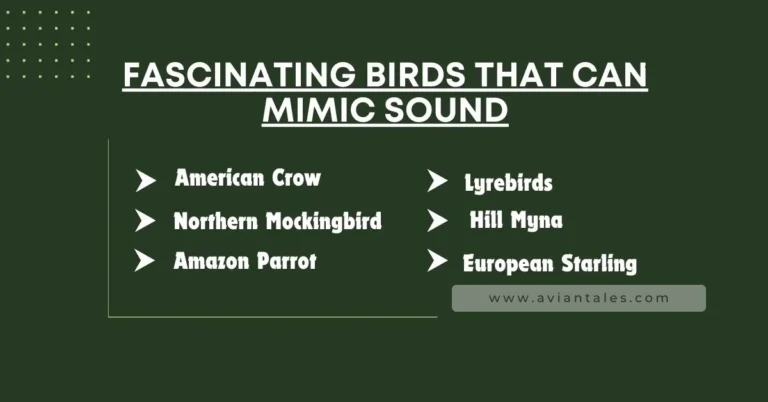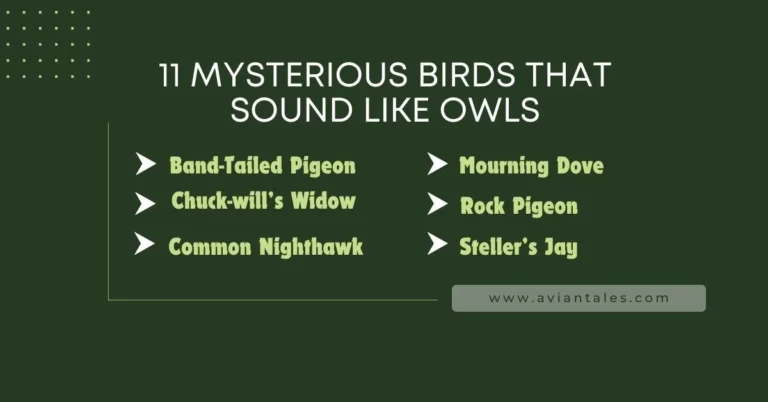6 Birds That Make a Hissing Sound at Night in Americas
Hoots, Hisses, and Howls: Eeriest Sounds of Birds in the Americas
Many birds are famous for their joyful and lovely songs, while others bring eerie and sad feelings. Owls, no doubt, are the common name when discussing the eerie bird’s sound. It is a fact that their eerie sounds haunt us, but they are not the only ones that are capable of eliciting fear. Some other birds make a hissing sound, such as the common potoo, turkey vulture, Common loon, and barred owl also frightens us with eerie sounds.
Birds that make a Hissing Sound
Are you excited to know the spookiest avian sounds in the Americas? If yes, start the discussion about these birds to drench your curiosity.
Barn Owl
Compared to other owls, barn owls don’t gently hoot at night, instead, they pierce the darkness with their sharp and harsh screeches. Both males and females can generate these sounds, but most often males produce them during flight.
They are found in many regions worldwide including in England, this is the place where Shakespeare is captivated by the owl and its shrill cries that he mentioned in several plays. The lines by Shakespeare “Bring forth that fatal screech-owl to our house/ That nothing sang but death to us and ours” indicate his perception of owls.
Read more: Is it illegal to eat Owl?
In modern times, humans are the ones who deliver the fatal updates. Low-flying hunting patterns of barn owls put them in danger while crossing the road and the constant threat of collision with cars seriously affects their numbers. Furthermore, large-scale, farming practices turned many areas of their previous habitat inhospitable to them. Although the population of barn owls is difficult to count because of their secretive nature, their number is considered stable overall.
Common Potoo
Common Potoo is comically peculiar and has a frog-like appearance. You may expect the melody of Monstrous Croak, like a chorus of frogs in a horror film, but in fact, this bird carries a few surprises. Not only does it hold a tune, but its slow, sorrowful song might be the one hunting sound among all birds.
The story doesn’t end here, Potoo’s upper eyelids have many small slits that act as peek-holes during daytime. This enables them to keep an eye on threats while staying perfectly still, with their large eyes closed. Although, they are considered to be widely distributed over Central and South America, suspected to be declining because of their continuing habitat loss.
Note: This nocturnal bird is found in ABC-supported reserves like Tapichalaca in Ecuador, Barba Azul in Bolivia, El Dorado in Columbia, and Abra Patricia in Peru.
Common Loon
There are few birds whose calls are as sorrowful or unforgettable as the common Loon’s winter wail. Male and female produce howling and eerie calls that sound more than a little wolf-like, to announce their existence and find out other loons.
Common loons can be spotted throughout many areas of Canada and northern areas of the United States. Their population is referred to as stable but still, they experienced a regional decline in the Midwest and New England. Common threats are water pollution, drowning due to commercial fishing nets used by fishers, and lead poisoning due to ingested fishing sinkers,
Common Raven
Most famously they are associated with one word, “nevermore”, and have more than a little vocal dexterity. Common Raven has been observed producing 30-plus different sounds. Undoubtedly, their loud, guttural cracking sounds are well-known and can be heard from over a mile away.
Read more: Do you have a pet Raven?
Interestingly, this well-known sound has been largely missing from the landscape Edgar Allen Poe Knew when he wrote “The Raven” in 1845. During that time, ravens had almost disappeared from the eastern United States because its forests were swiftly felled. Raven returned with the regrowth of forests, their population is now at a peak in many areas.
Recently, the interest in the common raven has increased aside from their creeping calls and appearance. Research indicates their remarkable intelligence level. Some studies also suggest that they plan the tasks in advance, a skill that was considered to belong to humans only.
Barred Owl
These birds are typically recognized by their hoots, “who-cook-for-you” but things are different during courtship when these birds produce a melody of caws, shrieks, and gurgles along with haunting sounds.
Read more: Why owl hoot during daytime.
Historically, these nocturnal birds are found in the eastern United States. In the 19th century, fire control in the boreal forest and reforestation in the Great Plains enabled them to expand their territory. The population of these birds has gradually increased for the previous 50 years.
Barred owls prefer to nest in big deed trees, and are commonly found in mature forests. Their existence indicates the forest’s health in certain areas. Logging can be risky for these owls.
Turkey Vulture
With skull-like heads crumpled in the skin of raw meat, this bird looks like a character from a horror film. They not only eat dead like carrion, but also snakes, grasshoppers, turtles, chickens, and rotten pumpkins. They can also vomit smelly undigested carrions.
They can generate gruesome hiss when they are threatened and competing for carrion also known as carcass. Turkey Vultures are found in many areas of the United States during their breeding season. They occur throughout the years in the southern states and extend all the way down to South America.
Many decades ago, they were imperiled by pesticides, but now their population is increasing, and they are one of the most widespread large carnivorous birds in the United States.
FAQS
Wrapping Up
Some birds make hissing sounds to protect their territories. The birds that produced hissing g sounds are: barred owls, common loon, turkey vultures, common raven, Barn owls, and common potoo.




